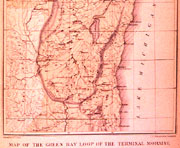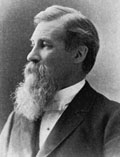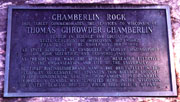
| Chamberlin
History of Geology |

Born: Sept. 25, 1843, Mattoon, Illinois.
Died: Nov. 15, 1928 in Chicago.
| Abstract | Introduction |
| Glacial geology | Later career |
| Chamberlin & Gilbert | References |

| Chamberlin
History of Geology |

Born: Sept. 25, 1843, Mattoon, Illinois.
Died: Nov. 15, 1928 in Chicago.
| Abstract | Introduction |
| Glacial geology | Later career |
| Chamberlin & Gilbert | References |
Chamberlin's career followed one overriding interest—glacial geology. Work with the Wisconsin Geological Survey and the USGS in the 1870-80s resulted in accurate mapping of the limits of glaciation in the United States, in basic laws of glacier ice movement, and in recognition of multiple glaciations. These results are contained in two classic monographs of the USGS: Preliminary paper on the terminal moraine of the second glacial epoch (1882) and The rock scorings of the great ice invasions (1886). Chamberlin developed the terminology for glacial stages in North America that is still utilized with some modifications.
His later interest expanded to consideration of the causes of glaciation and climatic change and ultimately to the origin of the Earth. He devised the "planetesimal theory" for the origin of the Earth, which contrasted with the more-popular nebular-gas-cloud theory. Chamberlin coauthored with Salisbury a widely used, three-volume college textbook, Geology (1906). A generation of geologists were trained with this text, and Chamberlin was highly regarded by contemporary and later geologists.
Chamberlin was born on a glacial moraine in Illinois, and the family moved to Beloit,
Wisconsin at age three. This was the prairie frontier region in the 1840s. His father
was an abolitionist and sometime preacher. Chamberlin graduated from Beloit College in
1866, where he had a classical education in Greek and Latin. He spent the next two years
as a high school principal in Wisconsin. In 1868-69, he took graduate courses, including
geology, at the University of Michigan. He was appointed professor of natural sciences
at the State Normal School (Wisconsin), 1869-73, and from 1873-82 he was professor of
geology at Beloit College. Meanwhile, he cofounded the Wisconsin Academy of Sciences in
1870.
Chamberlin explored the scientific process itself. He developed the method of "multiple
working hypotheses," which became the standard approach for several decades. It is still
widely utilized, but has been displaced by the "model-building method" in recent years.
Chamberlin saw two fundamental modes for investigation of the Earth.
Return to history of geology syllabus or schedule.Introduction
Chamberlin was a glacial geologist and science educator, who supported the concepts of
multiple glaciation and planetesimal origin of the Earth. He was the founding editor
of the Journal of Geology at the Department of Geology, University of Chicago.
Chamberlin was an unusually successful blend of field geologist, government bureaucrat,
university teacher and administrator, and cosmic theorist.Glacial geology
At the Wisconin Geological Survey, Chamberlin was the assistant state geologist (1873-76),
and he was promoted to Chief Geologist (1876-82), while still teaching at Beloit College.
In a 4-volume set on geology of Wisconsin, he introduced the concept of multiple (2) glacial
periods during the Ice Age (Quaternary Period), based on study of glacial moraines in
eastern Wisconsin. In 1881 he entered the U.S. Geological Survey, while still holding his
other appointments. He was placed in charge of the glacial division, where he remained until
1904. In 1882-87 he resided in Washington, D.C., and he taught at George Washington University
(1885-87). During this time, he was associated with many other well-known glacial geologists,
including J.E. Todd and L.C. Wooster who later worked in Kansas (Aber 1984).

Portrait of Thomas Chrowder Chamberlin in the 1870s. In the public domain; obtained from Wikimedia Commons.

Chamberlin's map of moraines in Wisconsin. This map was the first
demonstration of fundamental laws of glacier ice flow in lobate fashion. Taken from
Chamberlin (1882, plate XXIX). Later career of Chamberlin
Chamberlin served as President of the University of Wisconsin from 1887 til 1892. He
modernized the university from a classical emphasis to a scientific emphasis, a difficult
job for which he proved quite capable. In 1892, he accepted the Chair of the new Department
of Geology, University of Chicago. The U. of C. was founded and funded by J.D. Rockefellar
on the old World's Fairground. Thus, Chamberlin stepped down from full-time administrative
responsibilities in order to devote more time to geology. He assembled a hand-picked faculty,
including R.A.F. Penrose, Jr. Chamberlin founded and was first editor of the Journal of
Geology, which was established as a departmental journal in 1893. It was a convenient
forum for publication of his ideas in glacial stratigraphy. The Journal of Geology
became one of the leading geological journals, a status it continues to maintain today.

Portrait of Thomas Chrowder Chamberlin in 1897. In the public domain; obtained from Wikimedia Commons.
 Chamberlin's (1896) classification for North American
Chamberlin's (1896) classification for North American
glacial stages with subsequent modifications.
Glacial Stage
Interglacial
Modification Relative
Age
Wisconsin In current use
Toronto Replaced by Sangamon
Iowan (deleted)
interglacial (deleted)
Illinoian In current use
interglacial Now Yarmouth
Kansan Replaced by Independence
Aftonian (obsolete)
Albertan (obsolete)
Chamberlin retired from active duty at the University of Chicago and became professor
emeritus in 1919. He remained quite productive, nonetheless, until his death in 1928. Chamberlin was
highly regarded by his own and following generations. His scientific ideas and text
books were highly influential. A whole issue of Journal of Geology was devoted to him
in 1929, and a GSA symposium was held in 1989.

Memorial plaque for T.C. Chamberlin at the University of Wisconsin, Madison. Photo © J.S. Aber.
Chamberlin and Gilbert
Chamberlin and Gilbert had much in common during their early careers. Both were exceptional
field geologists, and both introduced important new concepts based on field investigations.
They were well acquainted with each other and maintained a friendly relationship. However,
their later careers show a divergence. Gilbert disliked administrative and bureaucratic
affairs, and he refused to teach. He remained a solitary field geologist to the end. In
contrast, Chamberlin enthusiastically took on ever greater teaching and administrative
burdens. Chamberlin's fame as an educator is equal to his stature as a geologist. In this
regard, Chamberlin had greater long-term impact on geology than did Gilbert.References

© J.S. Aber (2017).